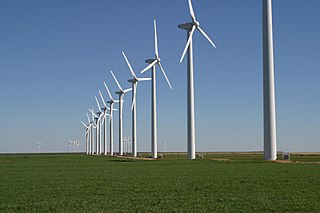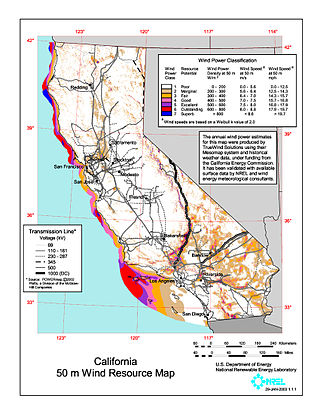
Wind power is a branch of the energy industry that has expanded quickly in the United States over the last several years. From January through December 2022, 434.8 terawatt-hours were generated by wind power, or 10.25% of electricity in the United States. The average wind turbine generates enough electricity in 46 minutes to power the average American home for one month. In 2019, wind power surpassed hydroelectric power as the largest renewable energy source in the U.S.

Wind power in California had initiative and early development during Governor Jerry Brown's first two terms in the late 1970s and early 1980s. The state's wind power capacity has grown by nearly 350% since 2001, when it was less than 1,700 MW. In 2016, wind energy supplied about 6.9% of California's total electricity needs, or enough to power more than 1.3 million households. Most of California's wind generation is found in the Tehachapi area of Kern County, California, with some large projects in Solano, Contra Costa and Riverside counties as well. California is among the states with the largest amount of installed wind power capacity. In recent years, California has lagged behind other states when it comes to the installation of wind power. It was ranked 4th overall for wind power electrical generation at the end of 2016 behind Texas, Iowa, and Oklahoma. As of 2019, California had 5,973 megawatts (MW) of wind power generating capacity installed.
New York has 2,192 MW of installed wind power capacity as of 2022. Most of New York's wind power is located in upstate New York as onshore wind farms. New York has set a goal of developing 9,000 MW of offshore installed wind power capacity by 2035 that will power an estimated 6 million homes. As of October 2022, New York has five offshore wind farms in development with approximately 4,300 MW installed capacity.

The U.S. state of Massachusetts has vast wind energy resources offshore, as well as significant resources onshore. The 2016 update to the states's Clean Energy and Climate Plan had a goal of reducing 1990 baseline greenhouse gas emissions levels by 25% by 2020. Current goals include installing 3,500 megawatts (MW) of offshore wind power in the state by 2035. However, as of Q4 2021 the state had only 120 MW of wind powered electricity generating capacity, responsible for generating 0.9% of in-state electricity production. The state has awarded contracts to two offshore projects, the 800 MW Vineyard Wind project and 804 MW Mayflower Wind project. Construction began on the Vineyard Wind 1 project on November 18, 2021, after a long fight for approval. Commonwealth Wind was selected for development in 2021, but the developer has attempted to cancel the project due to increased costs. There are eight projects planned for off the southern coast of Massachusetts, though some will deliver power to Rhode Island, Connecticut, and New York.

Walney Wind Farms are a group of offshore wind farms 9 miles (14 km) west of Walney Island off the coast of Cumbria, England, in the Irish Sea. The group, operated by Ørsted, consists of Walney Phase 1, Phase 2 and the Walney Extension. The extension has a capacity of 659 MW and it was the world's second largest offshore wind farm in 2018.
Wind power in New Jersey is in the early stages of development. New Jersey has just six wind turbines, but the state has plans to develop several major offshore wind projects on the continental shelf of the Atlantic Ocean off the southern Jersey Shore. Legislation has been enacted to support the industry through economic incentives and to permit wind turbines on existing piers.

Wind power in Michigan is a developing industry. The industrial base from the automotive industry has led to a number of companies producing wind turbine parts in the state. The development of wind farms in the state, however, has lagged behind. In January 2021, there were a total of 1,481 wind turbines in the state with a nameplate capacity of 2,549 MW. The nameplate total exceeded 2,000 MW when Pine River came online in March 2019. Wind provided 4.2% of the state's electricity in 2016.

Wind power in Hawaii has the potential to provide all of the electricity generation in the electricity sector in Hawaii. The 132 commercial wind turbines in the state have a total capacity of 236 MW. In 2015, wind turbines produced 6.4% of Hawaii's electricity. In 2012, Hawaii generated 367 million kWh from wind power.

Wind power in Rhode Island is in the early stages of development. There are several small scale wind turbine projects in the state. As of December 2013 there were 11 turbines at 10 sites in the state. In 2014, Rhode Island had 9 MW of installed wind power capacity, which quickly rose to 75 MW in 2019.

Wind power in Virginia is in the early stages of development. In March 2015, Virginia became the first state in the United States to receive a wind energy research lease to build and operate offshore wind turbines in federal waters. Virginia has no utility scale wind farms.

Wind power in Maryland, which has land-based and offshore resources, is in the early stages of development. As of 2016, Maryland has 191 megawatts (MW) of wind powered electricity generating capacity, responsible for 1.4% of in-state generated electricity. Two offshore wind farm projects that will supply wind-generated power to the state are underway.
US Wind is an offshore wind energy development company founded in 2011 that is a subsidiary of Italy-based Renexia SpA, part of Toto Holdings. It is headquartered in Baltimore, Maryland. Since 2014, it has been involved in one of the largest offshore wind farm projects in the United States.
Skipjack is a 966 MW capacity off shore wind farm, proposed by Ørsted US Offshore Wind to be built on the Outer Continental Shelf Offshore Delaware, approximately 16.9 nautical miles from the coast opposite Fenwick Island. It was originally projected that the project, which will provide power to Maryland, would be commissioned in 2022, It is one of the wind farm projects providing wind power to Maryland, the others being MarWin and Momentum Wind.
South Fork Wind Farm is a utility-scale offshore wind farm project on the Outer Continental Shelf Offshore Rhode Island (RI) which will provide energy to New York state.
Vineyard Wind 1 is an offshore wind farm under construction in U.S. federal waters in the Atlantic Ocean in Bureau of Ocean Energy Management-designated Lease Area OCS-A 0520, about 13 nautical miles south of Martha's Vineyard and Nantucket, Massachusetts. The array will include 62 wind turbines manufactured by GE Offshore Wind with a nameplate capacity of 804 MW combined, equivalent to the annual power use of 400,000 homes. The Massachusetts Department of Public Utilities approved the project in 2019. Construction began on November 18, 2021.

The Coastal Virginia Offshore Wind (CVOW) is an offshore wind energy project located about 43 km (27 mi) off the coast of Virginia Beach, Virginia, U.S. The initial phase, a two-turbine, 12-MW pilot project constructed in 2020, is the second utility scale offshore wind farm operating in the United States. Dominion Energy and Ørsted US Offshore Wind collaborated on the project, which is estimated to have cost $300 million and is expected to generate enough electricity to power up to 3,000 homes. It is the first utility scale wind farm serving Virginia and the first built in U.S. federal waters, in a wind lease area that covers about 2,135 acres.
Empire Wind is a proposed utility-scale offshore wind farm on the Outer Continental Shelf Offshore New York. It will be located in Bureau of Ocean Energy Management (BOEM) lease area OCS-A 0512 in the New York Bight about 15 miles (24 km) south of Jones Beach, Long Island.

Offshore wind power is in the early stages of development in the United States. In 2016, the United States Department of Energy estimated that the country has a gross resource potential of 10,800GW of offshore wind capacity, with a "technical" resource potential of 2,058GW. Offshore wind projects are under development in wind-rich areas of the East Coast, Great Lakes, and Pacific coast. The first commercial offshore wind farm, Block Island Wind Farm, began operation in 2016. As of 2017, about 30 projects totaling 24 gigawatts (GW) of potential installed capacity were being planned.












